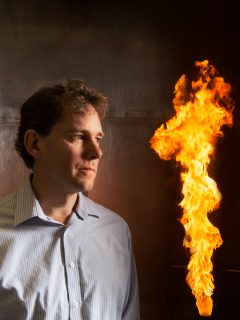–Written by Mitch Jackson
Bradley Conrad is one of the many Carleton graduate students working on the FlareNet project, which aims to provide a quantitative understanding of flare-generated pollutant emissions (i.e. “flaring”) which are critical to enabling science-based regulations.
Conrad called the sheer magnitude of gas flaring across the global oil and gas industry “startling”.
Conrad is a PhD student in Mechanical Engineering, who was involved in executing field measurements of black carbon (BC) emissions from gas flaring in Ecuador and Mexico. The end-goal of his research is to better characterize gas flaring as a source of BC emissions, enabling the development of accurate emission factors that relate BC emissions with flared volumes and various measurable flare metrics.
“Approximately 140 billion cubic metres of flare gas are burnt each year,” said Conrad.
“This is equivalent to about 3 to 5% of global natural gas demand and on the order of 20% of natural gas consumption in the United States.”
Emissions from gas flaring have been shown to have extremely strong climate-warming effects, but also significant impacts on public health.

Prof. Matthew Johnson. (photo by Luther Caverly)
“FlareNET will enable an improved quantitative understanding of the characteristics and magnitude of these emissions,” explained Conrad.
Professor Matthew Johnson, from the Department of Mechanical and Aerospace Engineering at Carleton University, is leading FlareNet and received major funding to support the project.
Johnson received $5.5 million from the Natural Sciences and Engineering Research Council of Canada (NSERC).
The project will also look to provide accurate pollutant inventories, understandings of climate forcing and health implications, and engineered mitigation strategies to minimize environmental impacts in the energy sector.
Darcy Corbin is a Master of Applied Science graduate who is working as a research engineer for Professor Johnson.
Corbin’s contribution to the project has been to design and build the Carleton Lab-Scale Flare facility over the last 5 years. Corbin also ran the first experiments in the facility which led to the completion of his thesis.
“I think that FlareNet can allow for the publication of research which could potentially better inform policy and regulations around flaring in the upstream oil and gas industry,” said Corbin on the project.
“As well, FlareNet can help us better quantify the environmental and social cost of flaring as an activity as Canada, provinces, and other jurisdictions move forward with different forms of carbon pricing.”

Federal Science Minister Kirsty Duncan, shaking hands with David Sawires. Bradley Conrad, Melina Jefferson and Darcy Corbin are standing behind them. (photo credit: James Park)
David Sawires is currently completing his Master of Applied Science in Mechanical Engineering and his thesis involves measuring soot formation inside flames. The results from his project would allow the researchers in the FlareNet project to better understand the soot formation inside the flames and develop better predictive soot models that they will use in their measurements.
Sawires credits his involvement in the project, as well as the supervision of Professor Johnson, with being able to acquire a job before graduation.
“To me, the FlareNet project highlights the importance of the work that Professor Johnson has been doing,” said Sawires.
“It’s a great opportunity to take the research forward and be able to develop models that will help in policy making as well as advance the available soot modelling and measuring technologies,” he added.
This understanding will hopefully lead to improved environmental performance, and effective, science-based regulations that can provide a benefit to Canada and the world.
To reach more about Carleton research about Flarenet, please click here.
Tuesday, January 10, 2017 in News, Research
Share: Twitter, Facebook



